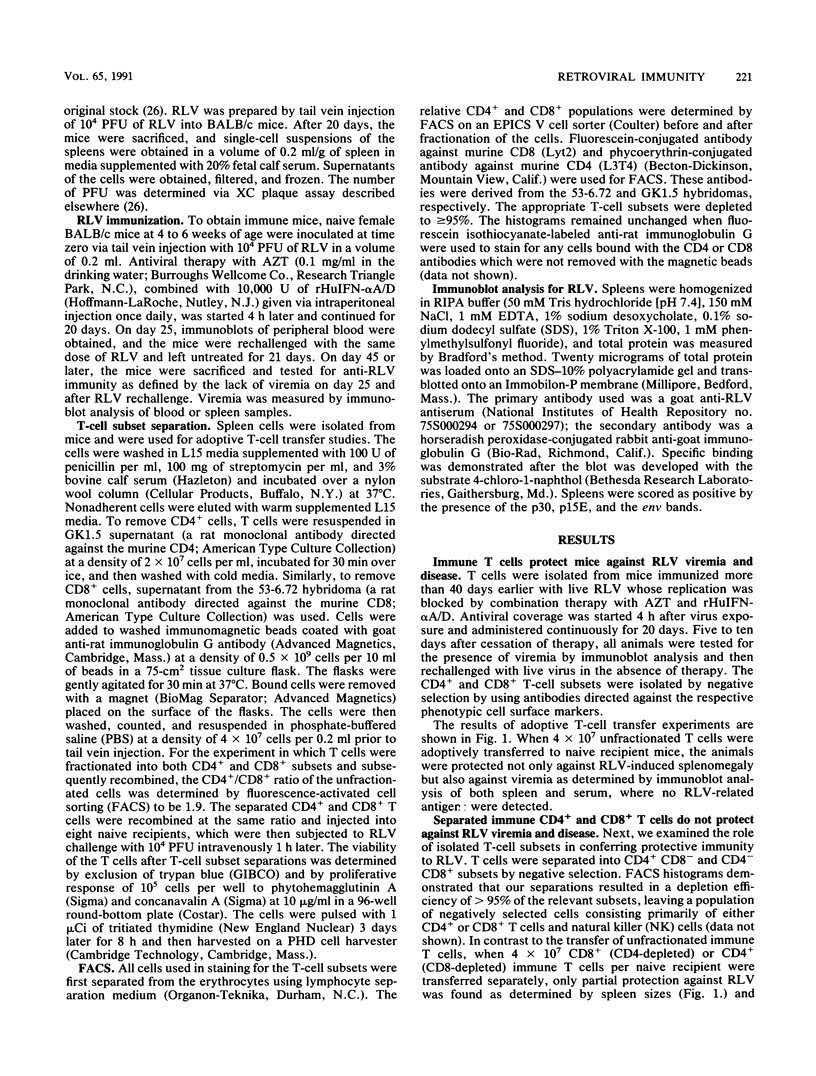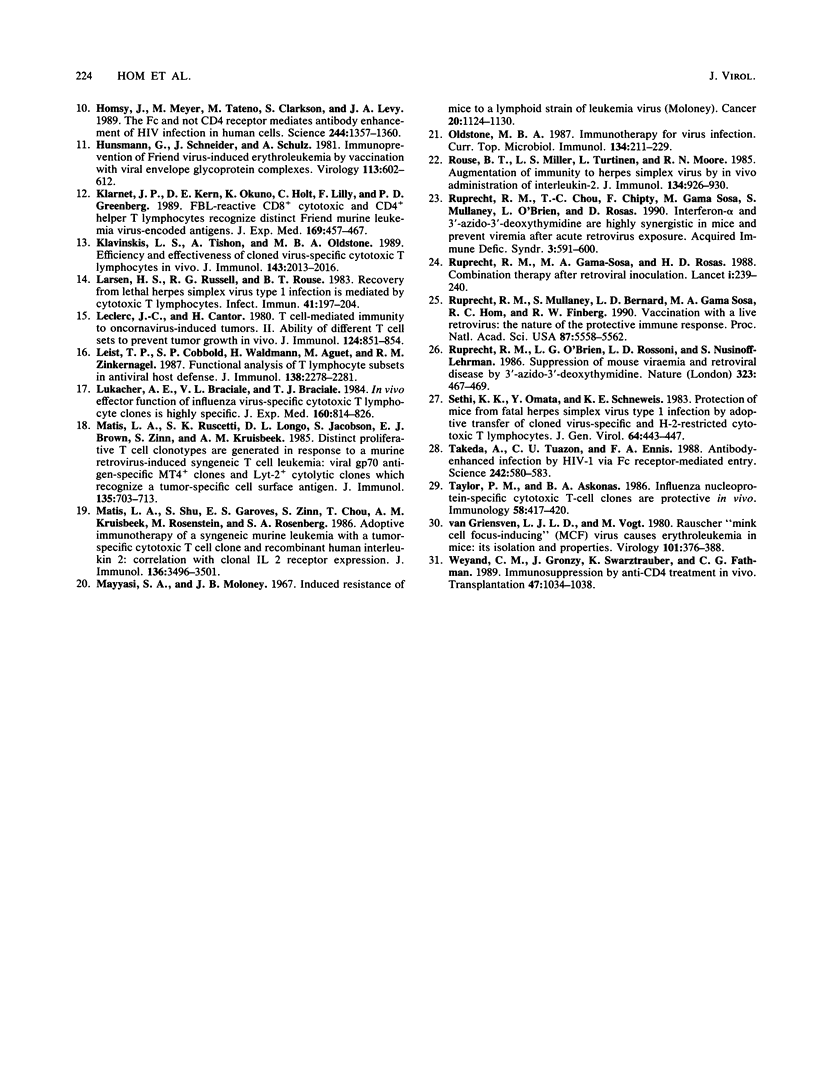Abstract
We have found previously that postexposure chemoprophylaxis with 3'-azido-3'-deoxythymidine (also known as zidovudine or AZT) in combination with recombinant human alpha A/D interferon fully protected mice exposed to a lethal dose of Rauscher murine leukemia virus (RLV) against viremia and disease. After cessation of therapy, over 90% of these mice were able to resist rechallenge with live RLV, thus demonstrating an acquired immunity. Adoptive cell transfer of 4 x 10(7) cells from immunized mice fully protected naive recipients from viremia and splenomegaly after RLV challenge. However, when these immune T cells were fractionated into CD4+ and CD8+ subpopulations, only partial protection was found when 4 x 10(7) T cells of either subset were given. Full protection against RLV challenge was seen again when the T-cell subsets from immunized mice were recombined and transferred at the same number into naive mice. We conclude that cellular immunity alone is protective and that both CD4+ and CD8+ cell types are required for conferring full protection against live virus challenge.
Full text
PDF




Images in this article
Selected References
These references are in PubMed. This may not be the complete list of references from this article.
- Bonneau R. H., Jennings S. R. Modulation of acute and latent herpes simplex virus infection in C57BL/6 mice by adoptive transfer of immune lymphocytes with cytolytic activity. J Virol. 1989 Mar;63(3):1480–1484. doi: 10.1128/jvi.63.3.1480-1484.1989. [DOI] [PMC free article] [PubMed] [Google Scholar]
- Bookman M. A., Swerdlow R., Matis L. A. Adoptive chemoimmunotherapy of murine leukemia with helper T lymphocyte clones. J Immunol. 1987 Nov 1;139(9):3166–3170. [PubMed] [Google Scholar]
- Britt W. J., Chesebro B. H-2D control of recovery from Friend virus leukemia: H-2D region influences the kinetics of the T lymphocyte response to Friend virus. J Exp Med. 1983 Jun 1;157(6):1736–1745. doi: 10.1084/jem.157.6.1736. [DOI] [PMC free article] [PubMed] [Google Scholar]
- Byrne J. A., Oldstone M. B. Biology of cloned cytotoxic T lymphocytes specific for lymphocytic choriomeningitis virus: clearance of virus in vivo. J Virol. 1984 Sep;51(3):682–686. doi: 10.1128/jvi.51.3.682-686.1984. [DOI] [PMC free article] [PubMed] [Google Scholar]
- Earl P. L., Moss B., Morrison R. P., Wehrly K., Nishio J., Chesebro B. T-lymphocyte priming and protection against Friend leukemia by vaccinia-retrovirus env gene recombinant. Science. 1986 Nov 7;234(4777):728–731. doi: 10.1126/science.3490689. [DOI] [PubMed] [Google Scholar]
- FINK M. A., RAUSCHER F. J. IMMUNE REACTIONS TO A MURINE LEUKEMIA VIRUS. I. INDUCTION OF IMMUNITY TO INFECTION WITH VIRUS IN THE NATURAL HOST. J Natl Cancer Inst. 1964 May;32:1075–1082. [PubMed] [Google Scholar]
- FRIEND C. Immunological relationships of a filterable agent causing a leukemia in adult mice. I. The neutralization of infectivity by specific antiserum. J Exp Med. 1959 Feb 1;109(2):217–228. doi: 10.1084/jem.109.2.217. [DOI] [PMC free article] [PubMed] [Google Scholar]
- Flyer D. C., Burakoff S. J., Faller D. V. The immune response to Moloney murine leukemia virus-induced tumors: induction of cytolytic T lymphocytes specific for both viral and tumor-associated antigens. J Immunol. 1986 Dec 15;137(12):3968–3972. [PubMed] [Google Scholar]
- Homsy J., Meyer M., Tateno M., Clarkson S., Levy J. A. The Fc and not CD4 receptor mediates antibody enhancement of HIV infection in human cells. Science. 1989 Jun 16;244(4910):1357–1360. doi: 10.1126/science.2786647. [DOI] [PubMed] [Google Scholar]
- Hunsmann G., Schneider J., Schulz A. Immunoprevention of Friend virus-induced erythroleukemia by vaccination with viral envelope glycoprotein complexes. Virology. 1981 Sep;113(2):602–612. doi: 10.1016/0042-6822(81)90188-4. [DOI] [PubMed] [Google Scholar]
- Klarnet J. P., Kern D. E., Okuno K., Holt C., Lilly F., Greenberg P. D. FBL-reactive CD8+ cytotoxic and CD4+ helper T lymphocytes recognize distinct Friend murine leukemia virus-encoded antigens. J Exp Med. 1989 Feb 1;169(2):457–467. doi: 10.1084/jem.169.2.457. [DOI] [PMC free article] [PubMed] [Google Scholar]
- Klavinskis L. S., Tishon A., Oldstone M. B. Efficiency and effectiveness of cloned virus-specific cytotoxic T lymphocytes in vivo. J Immunol. 1989 Sep 15;143(6):2013–2016. [PubMed] [Google Scholar]
- Larsen H. S., Russell R. G., Rouse B. T. Recovery from lethal herpes simplex virus type 1 infection is mediated by cytotoxic T lymphocytes. Infect Immun. 1983 Jul;41(1):197–204. doi: 10.1128/iai.41.1.197-204.1983. [DOI] [PMC free article] [PubMed] [Google Scholar]
- Leclerc J. C., Cantor H. T cell-mediated immunity to oncornavirus-induced tumors. II. Ability of different T cell sets to prevent tumor growth in vivo. J Immunol. 1980 Feb;124(2):851–854. [PubMed] [Google Scholar]
- Leist T. P., Cobbold S. P., Waldmann H., Aguet M., Zinkernagel R. M. Functional analysis of T lymphocyte subsets in antiviral host defense. J Immunol. 1987 Apr 1;138(7):2278–2281. [PubMed] [Google Scholar]
- Lukacher A. E., Braciale V. L., Braciale T. J. In vivo effector function of influenza virus-specific cytotoxic T lymphocyte clones is highly specific. J Exp Med. 1984 Sep 1;160(3):814–826. doi: 10.1084/jem.160.3.814. [DOI] [PMC free article] [PubMed] [Google Scholar]
- Matis L. A., Ruscetti S. K., Longo D. L., Jacobson S., Brown E. J., Zinn S., Kruisbeek A. M. Distinct proliferative T cell clonotypes are generated in response to a murine retrovirus-induced syngeneic T cell leukemia: viral gp70 antigen-specific MT4+ clones and Lyt-2+ cytolytic clones which recognize a tumor-specific cell surface antigen. J Immunol. 1985 Jul;135(1):703–713. [PubMed] [Google Scholar]
- Matis L. A., Shu S., Groves E. S., Zinn S., Chou T., Kruisbeek A. M., Rosenstein M., Rosenberg S. A. Adoptive immunotherapy of a syngeneic murine leukemia with a tumor-specific cytotoxic T cell clone and recombinant human interleukin 2: correlation with clonal IL 2 receptor expression. J Immunol. 1986 May 1;136(9):3496–3501. [PubMed] [Google Scholar]
- Mayyasi S. A., Moloney J. B. Induced resistance of mice to a lymphoid strain of leukemia virus (Moloney). Cancer. 1967 Jul;20(7):1124–1130. doi: 10.1002/1097-0142(196707)20:7<1124::aid-cncr2820200715>3.0.co;2-3. [DOI] [PubMed] [Google Scholar]
- Oldstone M. B. Immunotherapy for virus infection. Curr Top Microbiol Immunol. 1987;134:211–229. doi: 10.1007/978-3-642-71726-0_9. [DOI] [PubMed] [Google Scholar]
- Rouse B. T., Miller L. S., Turtinen L., Moore R. N. Augmentation of immunity to herpes simplex virus by in vivo administration of interleukin 2. J Immunol. 1985 Feb;134(2):926–930. [PubMed] [Google Scholar]
- Ruprecht R. M., Chou T. C., Chipty F., Sosa M. G., Mullaney S., O'Brien L., Rosas D. Interferon-alpha and 3'-azido-3'-deoxythymidine are highly synergistic in mice and prevent viremia after acute retrovirus exposure. J Acquir Immune Defic Syndr. 1990;3(6):591–600. [PubMed] [Google Scholar]
- Ruprecht R. M., Gama-Sosa M. A., Rosas H. D. Combination therapy after retroviral inoculation. Lancet. 1988 Jan 30;1(8579):239–240. doi: 10.1016/s0140-6736(88)91087-2. [DOI] [PubMed] [Google Scholar]
- Ruprecht R. M., Mullaney S., Bernard L. D., Gama Sosa M. A., Hom R. C., Finberg R. W. Vaccination with a live retrovirus: the nature of the protective immune response. Proc Natl Acad Sci U S A. 1990 Jul;87(14):5558–5562. doi: 10.1073/pnas.87.14.5558. [DOI] [PMC free article] [PubMed] [Google Scholar]
- Ruprecht R. M., O'Brien L. G., Rossoni L. D., Nusinoff-Lehrman S. Suppression of mouse viraemia and retroviral disease by 3'-azido-3'-deoxythymidine. Nature. 1986 Oct 2;323(6087):467–469. doi: 10.1038/323467a0. [DOI] [PubMed] [Google Scholar]
- Sethi K. K., Omata Y., Schneweis K. E. Protection of mice from fatal herpes simplex virus type 1 infection by adoptive transfer of cloned virus-specific and H-2-restricted cytotoxic T lymphocytes. J Gen Virol. 1983 Feb;64(Pt 2):443–447. doi: 10.1099/0022-1317-64-2-443. [DOI] [PubMed] [Google Scholar]
- Takeda A., Tuazon C. U., Ennis F. A. Antibody-enhanced infection by HIV-1 via Fc receptor-mediated entry. Science. 1988 Oct 28;242(4878):580–583. doi: 10.1126/science.2972065. [DOI] [PubMed] [Google Scholar]
- Taylor P. M., Askonas B. A. Influenza nucleoprotein-specific cytotoxic T-cell clones are protective in vivo. Immunology. 1986 Jul;58(3):417–420. [PMC free article] [PubMed] [Google Scholar]
- Weyand C. M., Goronzy J., Swarztrauber K., Fathman C. G. Immunosuppression by anti-CD4 treatment in vivo. Persistence of secondary antiviral immune responses. Transplantation. 1989 Jun;47(6):1034–1038. doi: 10.1097/00007890-198906000-00023. [DOI] [PubMed] [Google Scholar]
- de Graaf P. W., Horak E., Bookman M. A. Adoptive immunotherapy of syngeneic murine leukemia is enhanced by the combination of recombinant IFN-gamma and a tumor-specific cytotoxic T cell clone. J Immunol. 1988 Apr 15;140(8):2853–2857. [PubMed] [Google Scholar]
- van Griensven L. J., Vogt M. Rauscher "mink cell focus-inducing" (MCF) virus causes erythroleukemia in mice: its isolation and properties. Virology. 1980 Mar;101(2):376–388. doi: 10.1016/0042-6822(80)90451-1. [DOI] [PubMed] [Google Scholar]



